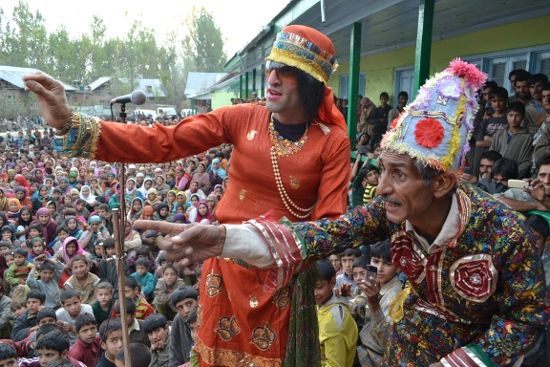 Bhand Pather - using traditional theatre for peacebuilding in Kashmir
Bhand Pather - using traditional theatre for peacebuilding in KashmirThe notion of ‘peacebuilding’ emerged in this backdrop as part of an enduring process to attain peace. The objective is to promote a world free from the curses of conflict and war. Since the mid-twentieth century, much effort has gone towards conceptualising and building the blocks of peace. Yet, peacebuilding is yet to emerge as a substitute to the toxic cycles of conflict.
To compliment peacebuilding efforts, this article introduces the notion of ‘choreography’. The idea for introducing choreography in a peace context is to draw parallels from the techniques applied in popular entertainment to better help peacebuilders design interventions.
Design of choreography
The key role of choreography in entertainment is to sequence and synchronize motion or form in dance, entertainment or music. A choreographer is one who creates routines to impact the mind of the audience, designs sequences of moves by means of notation, specifies motion and form in detail mirroring, shadowing and signalling, and a range of other moves.
Choreography and peacebuilding
A seven-fold stage is shown in the charts below for a peace choreographer. The moves in the 1st 4-stages are focused on ranges of conflict, the 5th has a mix of levels in strategic continuum (red) and in peace continuum (olive green), the 6th identifies a peacebuilding continuum in both diagnosis and prognoses, with steps needed for transition from negative to positive peace, and the 7th focuses on positive peacebuilding. At every stage of this process peace choreographers must act as social engineers or physicians: building peace blocks, providing prescriptions, tune notation, specifying form in detail mirroring, shadowing and signalling.
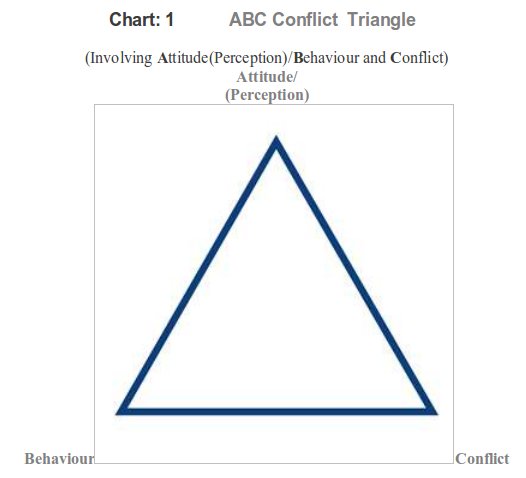
Notations in conflict
At stages of diagnosis the peace choreographers may confront the complexity of a conflict situation, and will have to shape moves in such a way as to, as Johan Galtung envisions, “engineer away” conflicts. The conflict will identify structures of conflict/war, ideologies, parties involved, motivation and objectives, and more. The peace moves have to target each aspect to be successful.
Peacebuilding fails when a peace choreographer fails to diagnose what constitutes a conflict, what of conflicts constitute a threat to peace or how a peacebuilder can prevent escalation.
A conflict shapes itself in an ABC triangle: Attitude/perception moulds Behaviour, which then leads to Conflict in a vicious cycle (Chart 2). A conflict may be of low intensity or high intensity, moving through crisis to war. It may be at the individual, community, national or global levels. It may become asymmetric or symmetric, depending upon level of power structure, levels of weaponry used and may result in humanitarian disasters or mass slaughter (Charts 3-4).
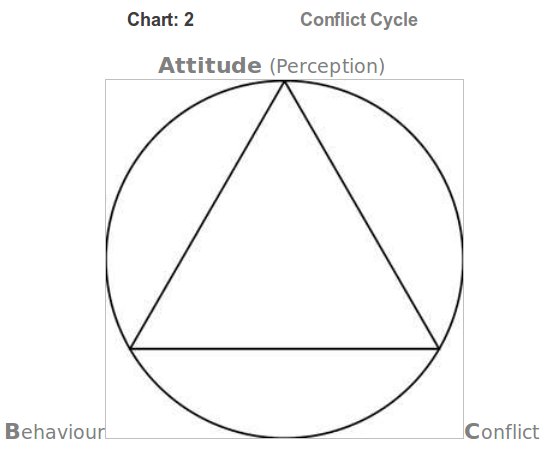
A peace choreographer has to tune on delicate notation in every move, recording the tantalizing challenges of strategic decisions, being prompted to tune in a cohesive manner towards building peace, portending moves which may serve, if not as panacea, at least providing creative solutions to the up-and-coming problems of peacebuilding.


Peace design in a strategic continuum
Peace choreography becomes most challenging at the stage of 'strategic continuum'. The players here are entrenched in high intensity conflict and posturing (Chart 5). This follows an implicit failure of conflict groups to identify their perceptual divide. This has ramifications for peacebuilding, as all moves to a 'peace continuum' are stalled due to the bargaining behaviour and the mutual rigidities of the partisans.
Nevertheless, a peacebuilder cannot but remain focused on a way to shift away from strategic continuum to a peace continuum i.e. moving through negative and positive peacebuilding to integration and development (Charts 5-6). Towards this end channels of communication must not be allowed to subside, and intermediaries must must work to raise confidence and hope in peacebuilding .
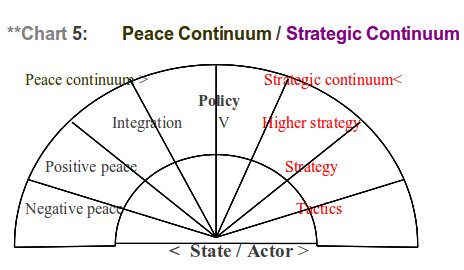
Negative peacebuilding
As conflict moves from latent/low intensity to overt or high intensity, the peace choreographer must remain focused how to make counter moves & ensure that the road to peace is not lost. A 'policy dancing' may (as is suggested in Chart 6; steps 1 - 6) follow at relevant levels of decision-making by those who are not merely interested in ending overt conflict, but as a way to shift all involved from impasse or stalemate to recognising mutual interests.
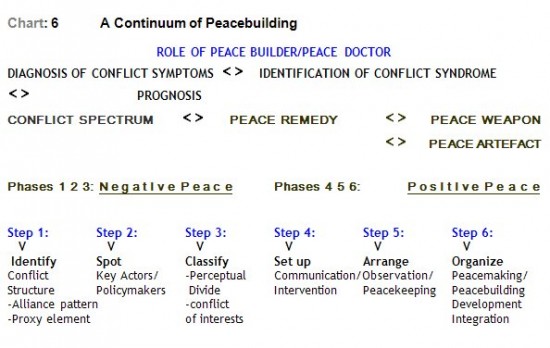
To begin with, this may involve peacekeeping. In such a situation a coordinated peace process has to be in place to curb the process of escalation, with peacekeepers preventing an aggravation of conflict, alongside efforts to show conflict parties their mutual interests in peace. Peace posturing must replace strategic posturing. Efforts may also follow to avoid spoilers damaging the peace process.
Multiple 'policy dancing' may have to involve high profile meetings between and among the conflicting parties. Regular levels of meetings at the operational and/or technical levels, and working with low-level contacts can be facilitated as part of confidence-building efforts. Communication, conversation, and dialogue may lead to mutual concessions. Conflict may thus step back to de-escalation, moving to a higher level of peacebuilding, passing through the dark tunnels with rays of light in view.
Positive Peacebuilding
Peace design at the level of positive peacebuilding must remain focused and active to exact or induce further concessions with the goal of finding a ‘win-win’ solution. Many issues may arise over a range of problems (Charts 6-7) which may need multiple 'policy dance' routines. An organic intervention process must ensue a shift away from strategic to peace continuum, lead to cooperative relationships, enabling the partisans to feel they have achieved success.
Externally imposed, or 'top-down', planning must give way to joint-venture development projects through economic cooperation and cross-community links. Promoting local harmony, ensuring justice and tackling structural inequalities must be a priority. Economic/technical aid or development support may provide incentives, but ought not to be misperceived as asymmetric inputs. Civil society must be drawn in as part of public opinion mobilization, with a particular focus on social inclusion of children, women and deprived communities in environmental protection, participatory planning and project execution so that development reaches the grassroots.Conclusion
To bring the idea of choreography into a peacebuilding context may sound a little outlandish; but many a peace organisations are already using music and the arts to convey the universality of peace messages. Viewed in this context it seems proper to re-invent choreography in peace field, as it may enhance efforts to lay the foundations for peace. What seems pertinent is discuss is how to perfect an idea taken from entertainment for the unenviable task of peacebuilding in a peaceless world?









